Employment Legislation: Key Elements & Impact on HRM Decision-Making
VerifiedAdded on 2023/01/11
|7
|1500
|62
Essay
AI Summary
This essay explores the critical relationship between employment legislation and Human Resource Management (HRM) decision-making. It identifies key elements of employment law, including employee rights, employer responsibilities, and the role of trade unions. The analysis covers legal issues such as paid leave and minimum wage, highlighting their impact on HRM practices. The essay also discusses the Data Protection Act and anti-discrimination laws, emphasizing the importance of compliance for HR managers. Furthermore, it examines the function of trade unions in protecting workers' rights and ensuring fair labor practices through collective bargaining. The conclusion underscores the significance of these laws in creating a fair and equitable work environment, ultimately influencing HRM's strategic decisions.
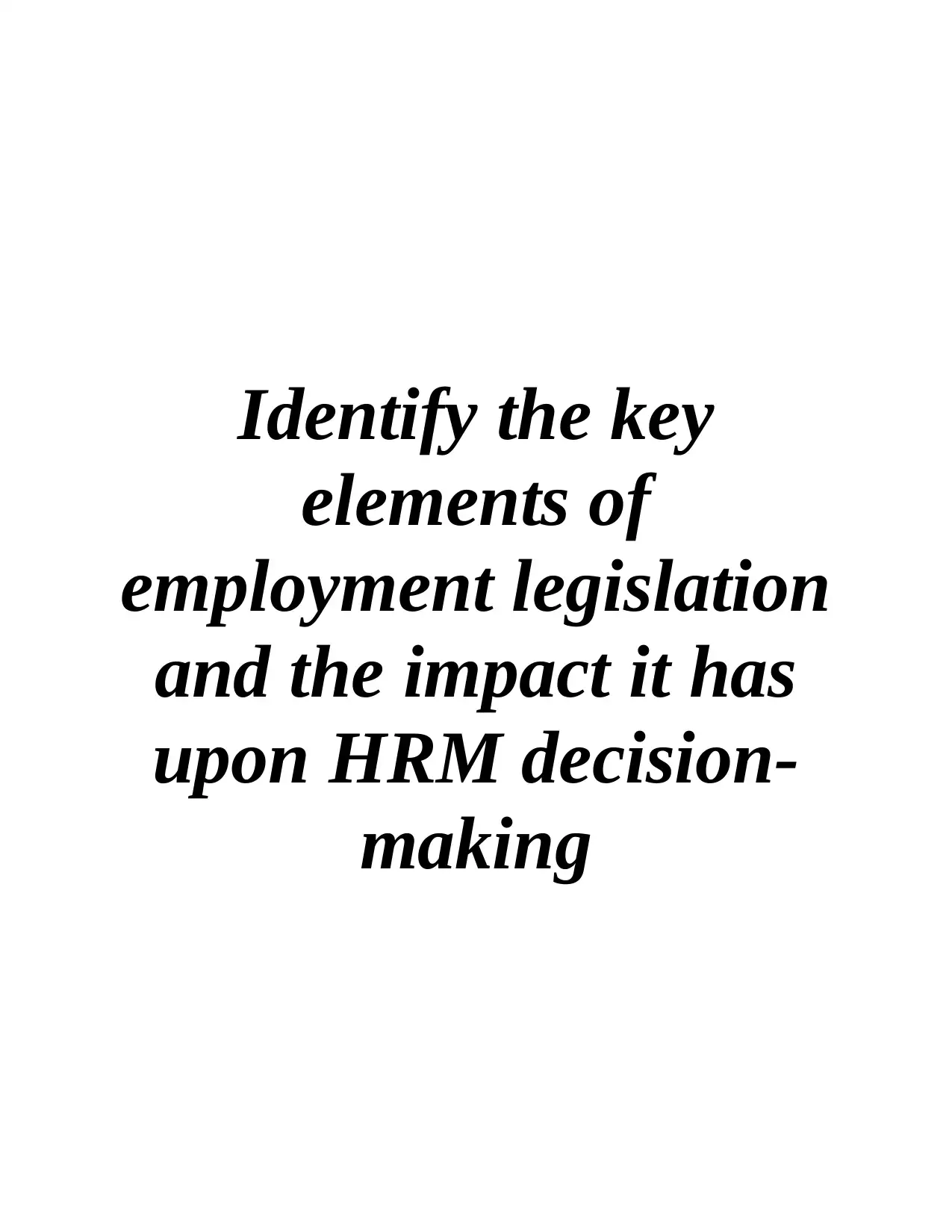
Identify the key
elements of
employment legislation
and the impact it has
upon HRM decision-
making
elements of
employment legislation
and the impact it has
upon HRM decision-
making
Paraphrase This Document
Need a fresh take? Get an instant paraphrase of this document with our AI Paraphraser

Table of Contents
INTRODUCTION...........................................................................................................................1
EMPLOYEE RELATION AND THE LAW..................................................................................1
The purpose of employment law key legal issues and constraints..............................................1
Trade unions and workplaces representational the role of trade unions local national collective
agreements...................................................................................................................................2
CONCLUSION................................................................................................................................3
REFERENCES................................................................................................................................4
INTRODUCTION...........................................................................................................................1
EMPLOYEE RELATION AND THE LAW..................................................................................1
The purpose of employment law key legal issues and constraints..............................................1
Trade unions and workplaces representational the role of trade unions local national collective
agreements...................................................................................................................................2
CONCLUSION................................................................................................................................3
REFERENCES................................................................................................................................4
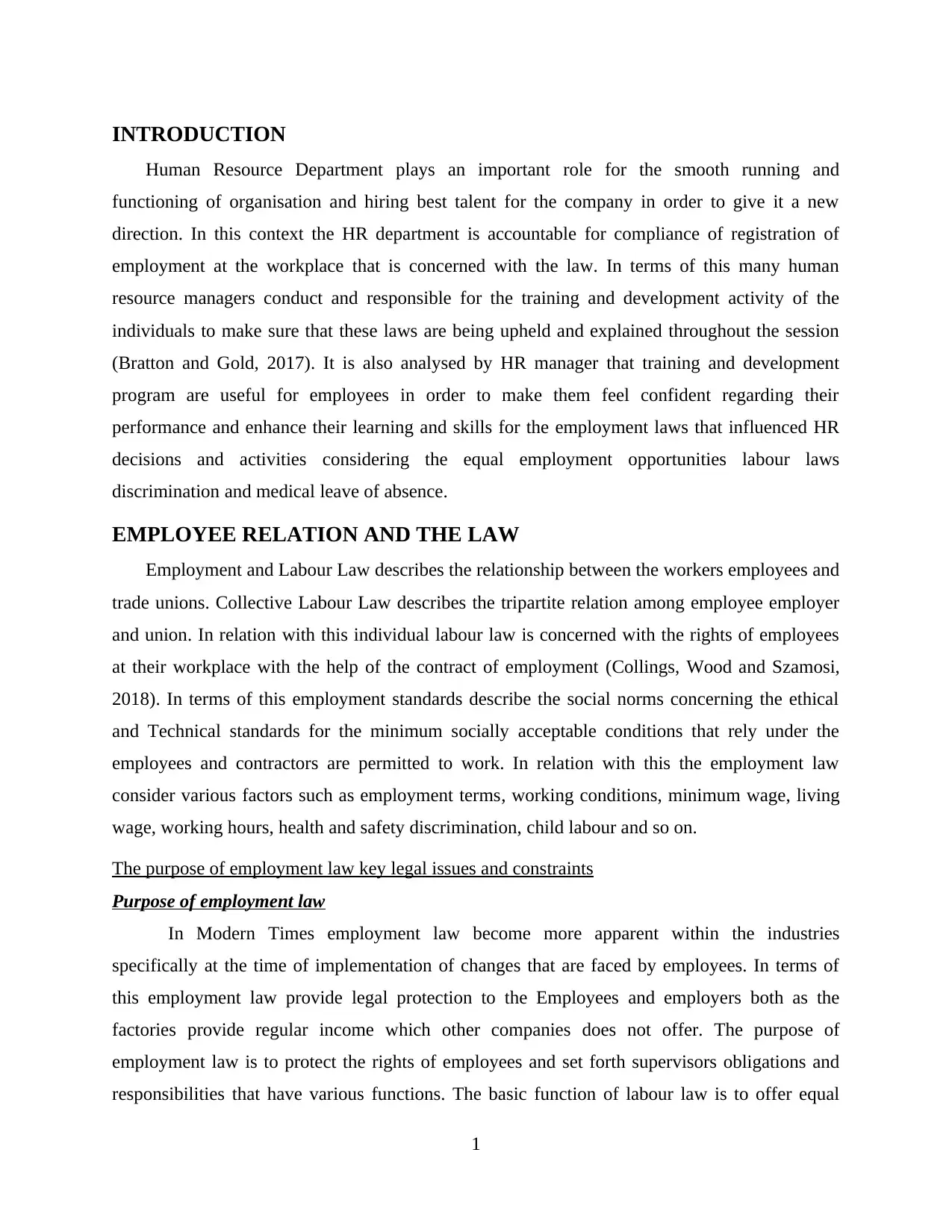
INTRODUCTION
Human Resource Department plays an important role for the smooth running and
functioning of organisation and hiring best talent for the company in order to give it a new
direction. In this context the HR department is accountable for compliance of registration of
employment at the workplace that is concerned with the law. In terms of this many human
resource managers conduct and responsible for the training and development activity of the
individuals to make sure that these laws are being upheld and explained throughout the session
(Bratton and Gold, 2017). It is also analysed by HR manager that training and development
program are useful for employees in order to make them feel confident regarding their
performance and enhance their learning and skills for the employment laws that influenced HR
decisions and activities considering the equal employment opportunities labour laws
discrimination and medical leave of absence.
EMPLOYEE RELATION AND THE LAW
Employment and Labour Law describes the relationship between the workers employees and
trade unions. Collective Labour Law describes the tripartite relation among employee employer
and union. In relation with this individual labour law is concerned with the rights of employees
at their workplace with the help of the contract of employment (Collings, Wood and Szamosi,
2018). In terms of this employment standards describe the social norms concerning the ethical
and Technical standards for the minimum socially acceptable conditions that rely under the
employees and contractors are permitted to work. In relation with this the employment law
consider various factors such as employment terms, working conditions, minimum wage, living
wage, working hours, health and safety discrimination, child labour and so on.
The purpose of employment law key legal issues and constraints
Purpose of employment law
In Modern Times employment law become more apparent within the industries
specifically at the time of implementation of changes that are faced by employees. In terms of
this employment law provide legal protection to the Employees and employers both as the
factories provide regular income which other companies does not offer. The purpose of
employment law is to protect the rights of employees and set forth supervisors obligations and
responsibilities that have various functions. The basic function of labour law is to offer equal
1
Human Resource Department plays an important role for the smooth running and
functioning of organisation and hiring best talent for the company in order to give it a new
direction. In this context the HR department is accountable for compliance of registration of
employment at the workplace that is concerned with the law. In terms of this many human
resource managers conduct and responsible for the training and development activity of the
individuals to make sure that these laws are being upheld and explained throughout the session
(Bratton and Gold, 2017). It is also analysed by HR manager that training and development
program are useful for employees in order to make them feel confident regarding their
performance and enhance their learning and skills for the employment laws that influenced HR
decisions and activities considering the equal employment opportunities labour laws
discrimination and medical leave of absence.
EMPLOYEE RELATION AND THE LAW
Employment and Labour Law describes the relationship between the workers employees and
trade unions. Collective Labour Law describes the tripartite relation among employee employer
and union. In relation with this individual labour law is concerned with the rights of employees
at their workplace with the help of the contract of employment (Collings, Wood and Szamosi,
2018). In terms of this employment standards describe the social norms concerning the ethical
and Technical standards for the minimum socially acceptable conditions that rely under the
employees and contractors are permitted to work. In relation with this the employment law
consider various factors such as employment terms, working conditions, minimum wage, living
wage, working hours, health and safety discrimination, child labour and so on.
The purpose of employment law key legal issues and constraints
Purpose of employment law
In Modern Times employment law become more apparent within the industries
specifically at the time of implementation of changes that are faced by employees. In terms of
this employment law provide legal protection to the Employees and employers both as the
factories provide regular income which other companies does not offer. The purpose of
employment law is to protect the rights of employees and set forth supervisors obligations and
responsibilities that have various functions. The basic function of labour law is to offer equal
1
⊘ This is a preview!⊘
Do you want full access?
Subscribe today to unlock all pages.

Trusted by 1+ million students worldwide
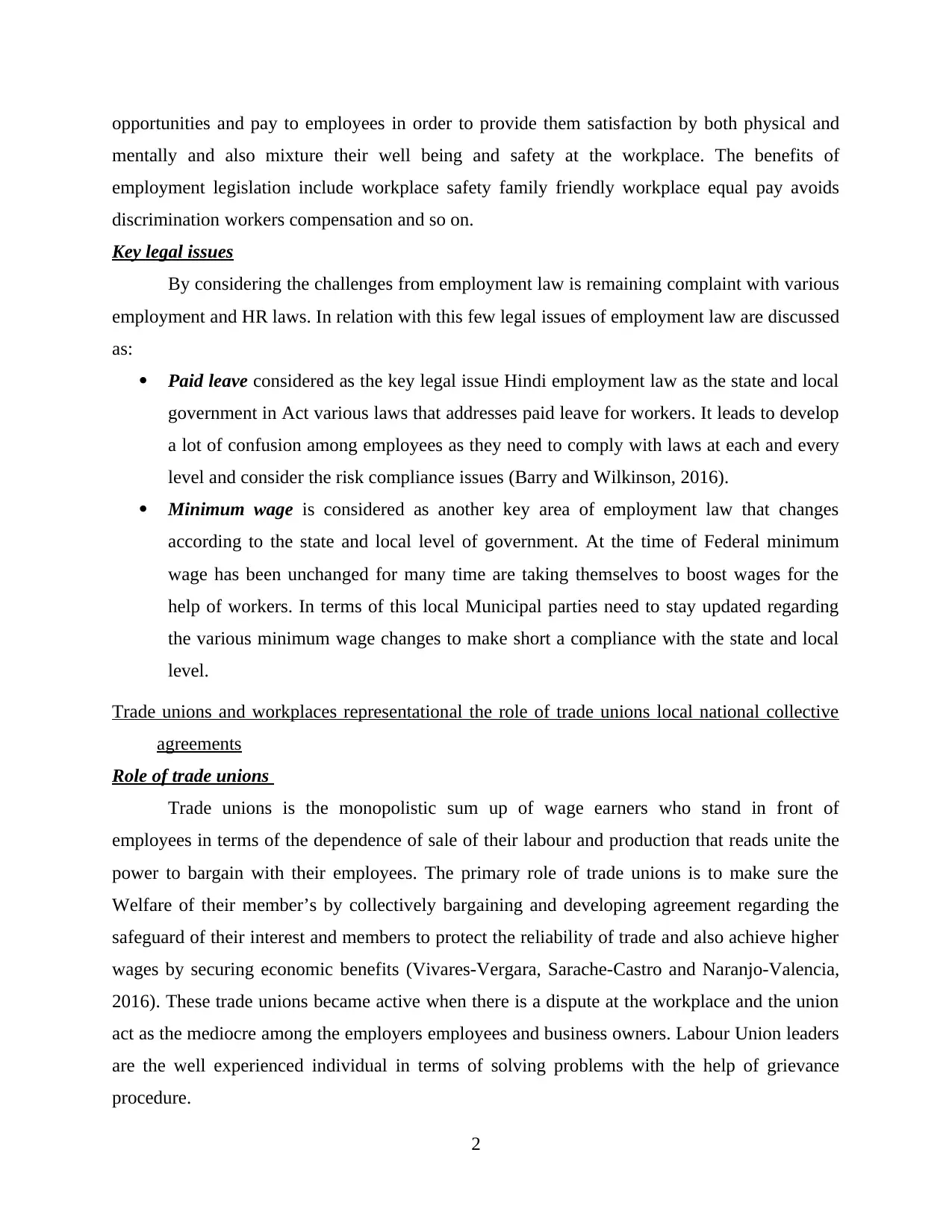
opportunities and pay to employees in order to provide them satisfaction by both physical and
mentally and also mixture their well being and safety at the workplace. The benefits of
employment legislation include workplace safety family friendly workplace equal pay avoids
discrimination workers compensation and so on.
Key legal issues
By considering the challenges from employment law is remaining complaint with various
employment and HR laws. In relation with this few legal issues of employment law are discussed
as:
Paid leave considered as the key legal issue Hindi employment law as the state and local
government in Act various laws that addresses paid leave for workers. It leads to develop
a lot of confusion among employees as they need to comply with laws at each and every
level and consider the risk compliance issues (Barry and Wilkinson, 2016).
Minimum wage is considered as another key area of employment law that changes
according to the state and local level of government. At the time of Federal minimum
wage has been unchanged for many time are taking themselves to boost wages for the
help of workers. In terms of this local Municipal parties need to stay updated regarding
the various minimum wage changes to make short a compliance with the state and local
level.
Trade unions and workplaces representational the role of trade unions local national collective
agreements
Role of trade unions
Trade unions is the monopolistic sum up of wage earners who stand in front of
employees in terms of the dependence of sale of their labour and production that reads unite the
power to bargain with their employees. The primary role of trade unions is to make sure the
Welfare of their member’s by collectively bargaining and developing agreement regarding the
safeguard of their interest and members to protect the reliability of trade and also achieve higher
wages by securing economic benefits (Vivares-Vergara, Sarache-Castro and Naranjo-Valencia,
2016). These trade unions became active when there is a dispute at the workplace and the union
act as the mediocre among the employers employees and business owners. Labour Union leaders
are the well experienced individual in terms of solving problems with the help of grievance
procedure.
2
mentally and also mixture their well being and safety at the workplace. The benefits of
employment legislation include workplace safety family friendly workplace equal pay avoids
discrimination workers compensation and so on.
Key legal issues
By considering the challenges from employment law is remaining complaint with various
employment and HR laws. In relation with this few legal issues of employment law are discussed
as:
Paid leave considered as the key legal issue Hindi employment law as the state and local
government in Act various laws that addresses paid leave for workers. It leads to develop
a lot of confusion among employees as they need to comply with laws at each and every
level and consider the risk compliance issues (Barry and Wilkinson, 2016).
Minimum wage is considered as another key area of employment law that changes
according to the state and local level of government. At the time of Federal minimum
wage has been unchanged for many time are taking themselves to boost wages for the
help of workers. In terms of this local Municipal parties need to stay updated regarding
the various minimum wage changes to make short a compliance with the state and local
level.
Trade unions and workplaces representational the role of trade unions local national collective
agreements
Role of trade unions
Trade unions is the monopolistic sum up of wage earners who stand in front of
employees in terms of the dependence of sale of their labour and production that reads unite the
power to bargain with their employees. The primary role of trade unions is to make sure the
Welfare of their member’s by collectively bargaining and developing agreement regarding the
safeguard of their interest and members to protect the reliability of trade and also achieve higher
wages by securing economic benefits (Vivares-Vergara, Sarache-Castro and Naranjo-Valencia,
2016). These trade unions became active when there is a dispute at the workplace and the union
act as the mediocre among the employers employees and business owners. Labour Union leaders
are the well experienced individual in terms of solving problems with the help of grievance
procedure.
2
Paraphrase This Document
Need a fresh take? Get an instant paraphrase of this document with our AI Paraphraser
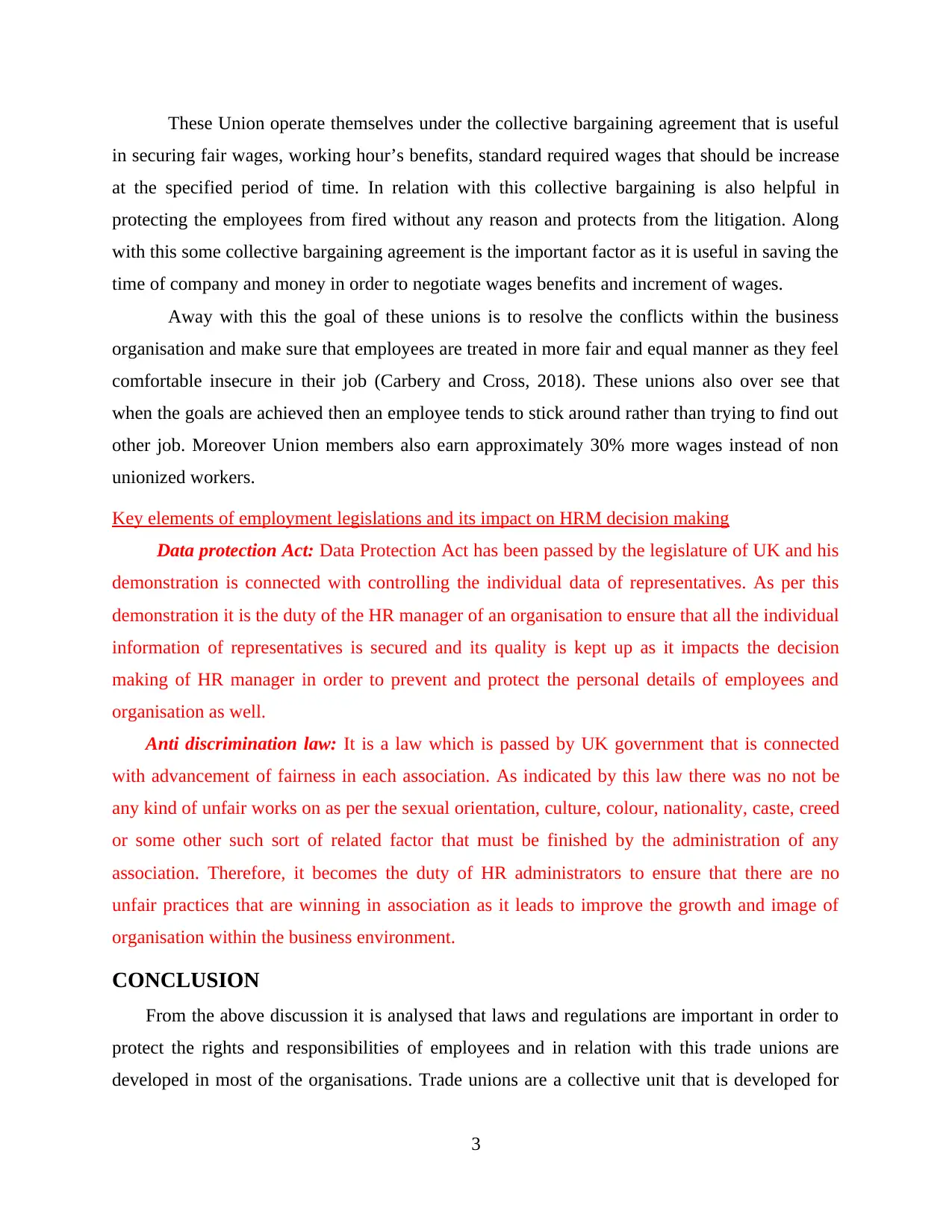
These Union operate themselves under the collective bargaining agreement that is useful
in securing fair wages, working hour’s benefits, standard required wages that should be increase
at the specified period of time. In relation with this collective bargaining is also helpful in
protecting the employees from fired without any reason and protects from the litigation. Along
with this some collective bargaining agreement is the important factor as it is useful in saving the
time of company and money in order to negotiate wages benefits and increment of wages.
Away with this the goal of these unions is to resolve the conflicts within the business
organisation and make sure that employees are treated in more fair and equal manner as they feel
comfortable insecure in their job (Carbery and Cross, 2018). These unions also over see that
when the goals are achieved then an employee tends to stick around rather than trying to find out
other job. Moreover Union members also earn approximately 30% more wages instead of non
unionized workers.
Key elements of employment legislations and its impact on HRM decision making
Data protection Act: Data Protection Act has been passed by the legislature of UK and his
demonstration is connected with controlling the individual data of representatives. As per this
demonstration it is the duty of the HR manager of an organisation to ensure that all the individual
information of representatives is secured and its quality is kept up as it impacts the decision
making of HR manager in order to prevent and protect the personal details of employees and
organisation as well.
Anti discrimination law: It is a law which is passed by UK government that is connected
with advancement of fairness in each association. As indicated by this law there was no not be
any kind of unfair works on as per the sexual orientation, culture, colour, nationality, caste, creed
or some other such sort of related factor that must be finished by the administration of any
association. Therefore, it becomes the duty of HR administrators to ensure that there are no
unfair practices that are winning in association as it leads to improve the growth and image of
organisation within the business environment.
CONCLUSION
From the above discussion it is analysed that laws and regulations are important in order to
protect the rights and responsibilities of employees and in relation with this trade unions are
developed in most of the organisations. Trade unions are a collective unit that is developed for
3
in securing fair wages, working hour’s benefits, standard required wages that should be increase
at the specified period of time. In relation with this collective bargaining is also helpful in
protecting the employees from fired without any reason and protects from the litigation. Along
with this some collective bargaining agreement is the important factor as it is useful in saving the
time of company and money in order to negotiate wages benefits and increment of wages.
Away with this the goal of these unions is to resolve the conflicts within the business
organisation and make sure that employees are treated in more fair and equal manner as they feel
comfortable insecure in their job (Carbery and Cross, 2018). These unions also over see that
when the goals are achieved then an employee tends to stick around rather than trying to find out
other job. Moreover Union members also earn approximately 30% more wages instead of non
unionized workers.
Key elements of employment legislations and its impact on HRM decision making
Data protection Act: Data Protection Act has been passed by the legislature of UK and his
demonstration is connected with controlling the individual data of representatives. As per this
demonstration it is the duty of the HR manager of an organisation to ensure that all the individual
information of representatives is secured and its quality is kept up as it impacts the decision
making of HR manager in order to prevent and protect the personal details of employees and
organisation as well.
Anti discrimination law: It is a law which is passed by UK government that is connected
with advancement of fairness in each association. As indicated by this law there was no not be
any kind of unfair works on as per the sexual orientation, culture, colour, nationality, caste, creed
or some other such sort of related factor that must be finished by the administration of any
association. Therefore, it becomes the duty of HR administrators to ensure that there are no
unfair practices that are winning in association as it leads to improve the growth and image of
organisation within the business environment.
CONCLUSION
From the above discussion it is analysed that laws and regulations are important in order to
protect the rights and responsibilities of employees and in relation with this trade unions are
developed in most of the organisations. Trade unions are a collective unit that is developed for
3

the protection of lights of employees in a legal manner. Trade unions are formed for the purpose
of securing the improvement in the paper benefits working conditions political and social status
with the help of collective bargaining that leads to enhance the bargaining power by banding of
the workers.
4
of securing the improvement in the paper benefits working conditions political and social status
with the help of collective bargaining that leads to enhance the bargaining power by banding of
the workers.
4
⊘ This is a preview!⊘
Do you want full access?
Subscribe today to unlock all pages.

Trusted by 1+ million students worldwide
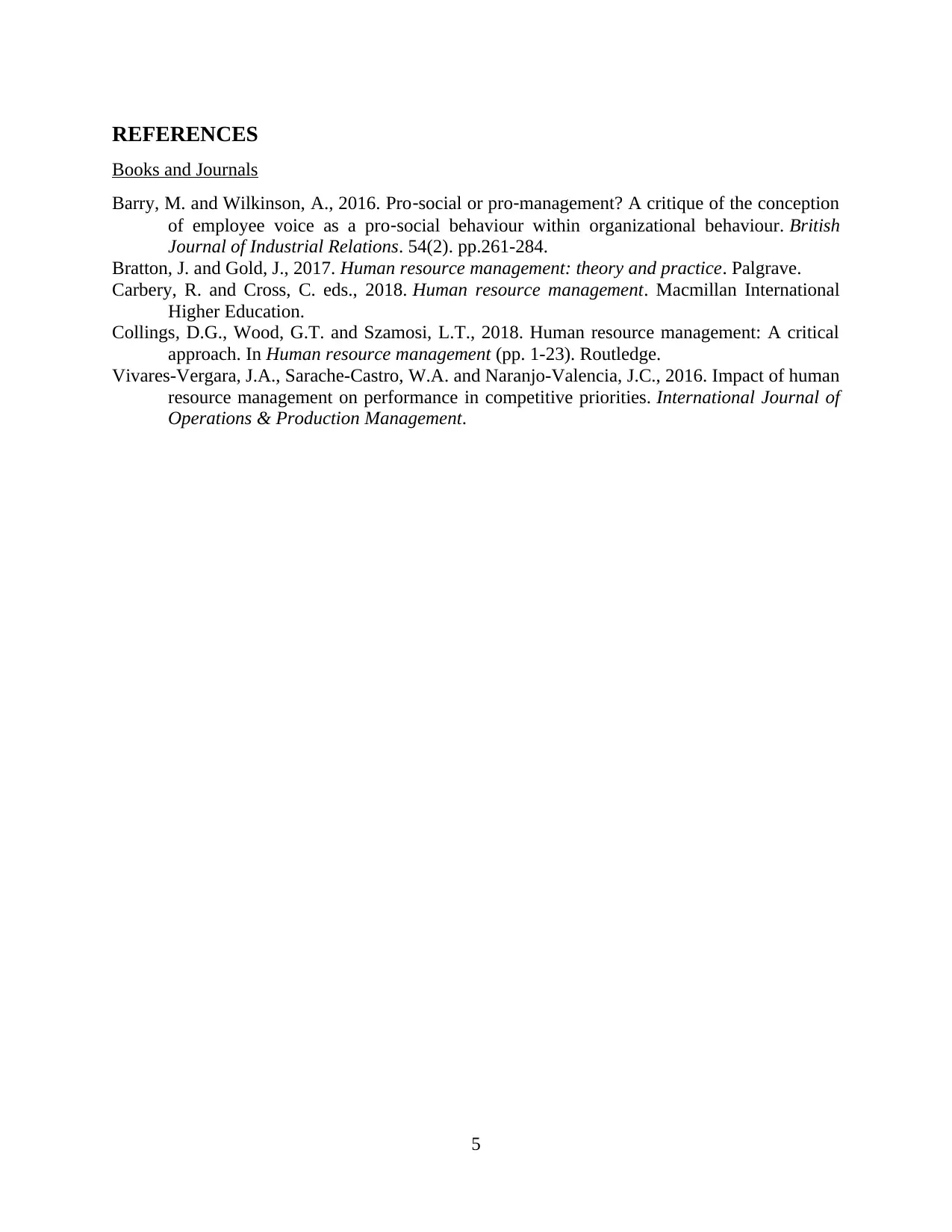
REFERENCES
Books and Journals
Barry, M. and Wilkinson, A., 2016. Pro‐social or pro‐management? A critique of the conception
of employee voice as a pro‐social behaviour within organizational behaviour. British
Journal of Industrial Relations. 54(2). pp.261-284.
Bratton, J. and Gold, J., 2017. Human resource management: theory and practice. Palgrave.
Carbery, R. and Cross, C. eds., 2018. Human resource management. Macmillan International
Higher Education.
Collings, D.G., Wood, G.T. and Szamosi, L.T., 2018. Human resource management: A critical
approach. In Human resource management (pp. 1-23). Routledge.
Vivares-Vergara, J.A., Sarache-Castro, W.A. and Naranjo-Valencia, J.C., 2016. Impact of human
resource management on performance in competitive priorities. International Journal of
Operations & Production Management.
5
Books and Journals
Barry, M. and Wilkinson, A., 2016. Pro‐social or pro‐management? A critique of the conception
of employee voice as a pro‐social behaviour within organizational behaviour. British
Journal of Industrial Relations. 54(2). pp.261-284.
Bratton, J. and Gold, J., 2017. Human resource management: theory and practice. Palgrave.
Carbery, R. and Cross, C. eds., 2018. Human resource management. Macmillan International
Higher Education.
Collings, D.G., Wood, G.T. and Szamosi, L.T., 2018. Human resource management: A critical
approach. In Human resource management (pp. 1-23). Routledge.
Vivares-Vergara, J.A., Sarache-Castro, W.A. and Naranjo-Valencia, J.C., 2016. Impact of human
resource management on performance in competitive priorities. International Journal of
Operations & Production Management.
5
1 out of 7
Related Documents
Your All-in-One AI-Powered Toolkit for Academic Success.
+13062052269
info@desklib.com
Available 24*7 on WhatsApp / Email
![[object Object]](/_next/static/media/star-bottom.7253800d.svg)
Unlock your academic potential
Copyright © 2020–2025 A2Z Services. All Rights Reserved. Developed and managed by ZUCOL.





